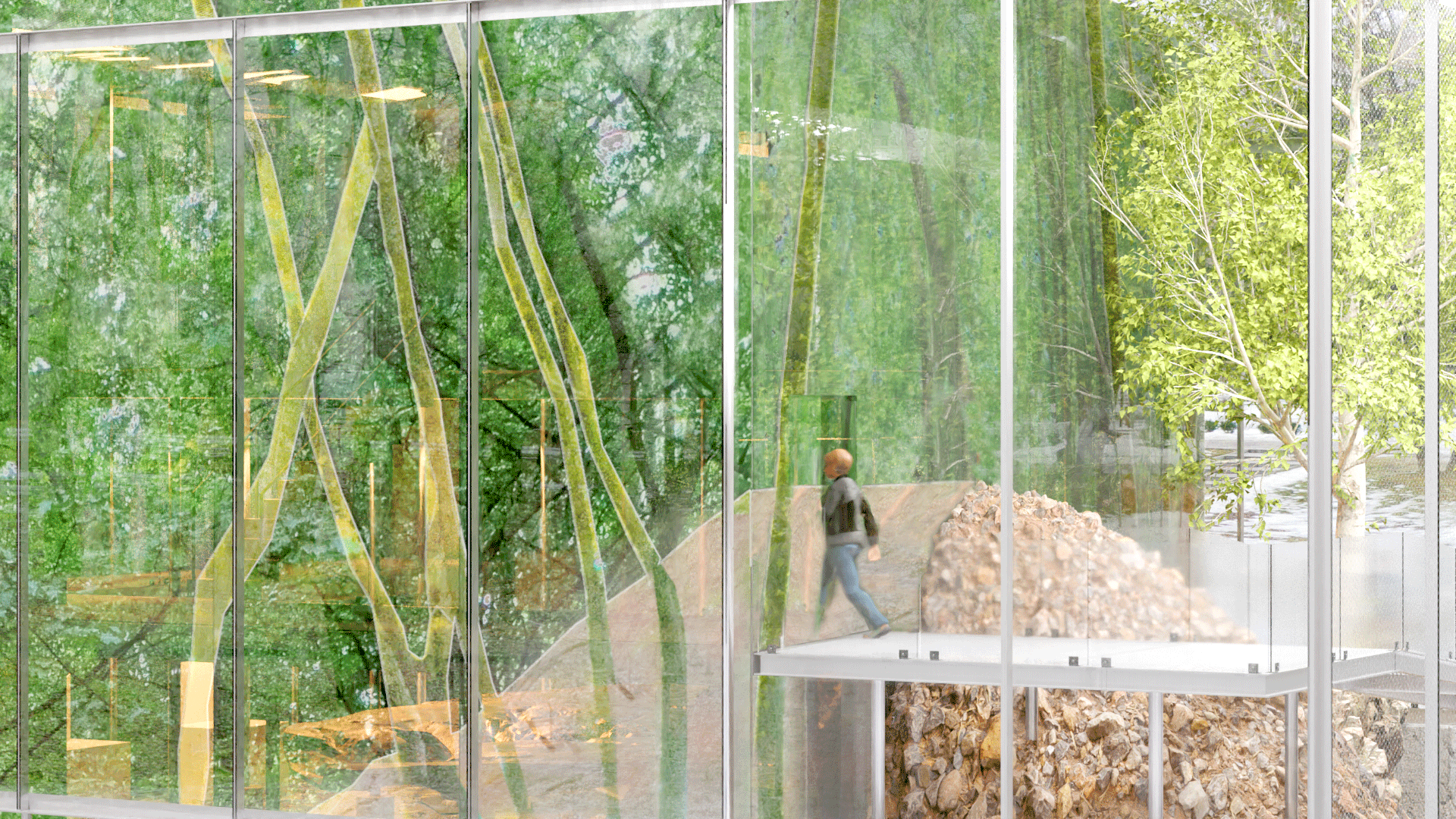Image Environments, Rendering Real
Contributor
Rendering Fiction

(T+E+A+M, Model Pavilion, 2021.)
This is a reflection on the possibility of architecture to help reground lived experience in media rich environments post-pandemic. It’s a mix of concern and hope. We’ve all lived through the loss and isolation of the past two years, a time where we saw an already alarming dependence on screens skyrocket. To re-center our experience on the world around us, architects might seek to weave aspects of screen-based digital technologies into the built environment in a way that connects us to our bodies and each other. This idea is presented below in short meditations on the words in the title, framed in relation to the editor’s theme.
Image. The editors invited me to write about ‘imaging,’ which I subsequently changed to ‘image.’ I imagine the former refers to the making of digital images, but I want to focus here on the things being made. Much of my writing has attempted to describe the transference of aesthetic characteristics from digital images into the broader physical world. Digital artifacts like pixels and glitches used to be limited to things made by the computer, but they’re now as common as polka-dots or the color red. This saturation of digital characteristics into everyday aesthetics is what I call postdigital, and it presents an expanded domain of materiality and authorship for architects. Its power lies in its ability to infuse space with the same vivid, visual traits our phones use to hold our attention. Optimistically, postdigital space might help us look up, or get off our devices entirely.
Environments. The second term I was asked to consider was ‘objects,’ which I changed to ‘environments’ in order to foreground spatial experience as immersive, temporal, sensory, and varied across bodies. Although there is an extensive discourse in architecture complexifying the concept of objects, the colloquial understanding of them as static things that we stand apart from risks decentering human beings in a time when we need to double down on people. Recently, my practice, T+E+A+M, designed a commemorative holocaust pavilion where visitors move through multiple layers of media as material. Sited above a mass grave in Eastern Europe, the earth excavated for the build is kept in the form of a pile that one walks past, peers down upon, and eventually stands atop in an experience that blends visual, haptic, and proprioceptive sensations with cognitive reflection. Inside, a large topographic model is embedded in the earthen pile, collapsing represented and literal ground and inviting visitors to consider the multiple temporalities present. Walking around, one sees reflections of trees mixing with their printed copies, while inside they peer through historical imagery to present-day views beyond. Images on glass is a screen-based aesthetic, but here you must move around to experience the full-set of effects. It doesn’t work standing still.
Rendering. This term was introduced by the editors and I kept it, as it’s action-based. We need urgency right now on so many fronts. Two years of extreme isolation and screen excess has made us forget how to be together, and resuming old ways aren’t working. Walking through the halls of my home institution, I feel a collective sense of being lost. I believe there’s an opportunity here to define how we gather and why it matters. What if we used ‘rendering’ as a metaphor for this type of social scripting? What architects do well is make images that depict pleasurable social life. What if this wasn’t limited to static pictures but applied to life as lived. As an example of what might be possible, I encourage everyone to check out Xavi Aguirre/stock-a-studio’s ‘Postcommodities’ conference at the University of Michigan last fall. We’ve all likely experienced failed attempts at ‘hybrid’ meetings these past two years, but Aguirre’s symposium was anything but. It staged a series of conversations between in-person and remote participants, simulcast through a website and a physical set mixed in real-time. It was the most thoughtful, engaging, and dynamic form of mixed presence I’ve encountered—like being suspended in a rendering, or an animation, awash in the colors and bright lights we love on our screens, but acutely aware of (and thankful for) the bodies around, including my own.
Real. The last change was one of opposites—swapping ‘fiction’ in the broadsheet title for ‘real’. If fiction is meant to describe an alternative reality that sits adjacent to the real, to me, fiction feels too slow right now. We’re out of time on so many fronts. Whether it’s addressing climate change, systemic racism, or extreme wealth inequality, the world we’ve made needs to be unmade and remade now. If architects have agency in envisioning worlds, then perhaps they should be ones we take up immediately. As it relates to the digital, I would take the recent rise of immersive art experiences, from Meow Wolf to Pace’s SuperBlue gallery in Miami, as an invitation to architects to think through the merging of screen-based aesthetics and physical spaces with more care, nuance, and will to democratize. How might the world we shape through architecture fold in the rapturous luminosity of our screens in a way that centers rather than overwhelms our sensory capacities? How might physical space invite us to look up or get off our screens, not in wholesale rejection, but because those same vibrant visuals are woven into our surroundings? This is a call for a digitally infused, body centric, social play that architects might claim—rendering image environments real and teaching us how to be human again.
Adam Fure is a principal of T+E+A+M and an Associate Professor at The University of Michigan Taubman College of Architecture and Urban Planning